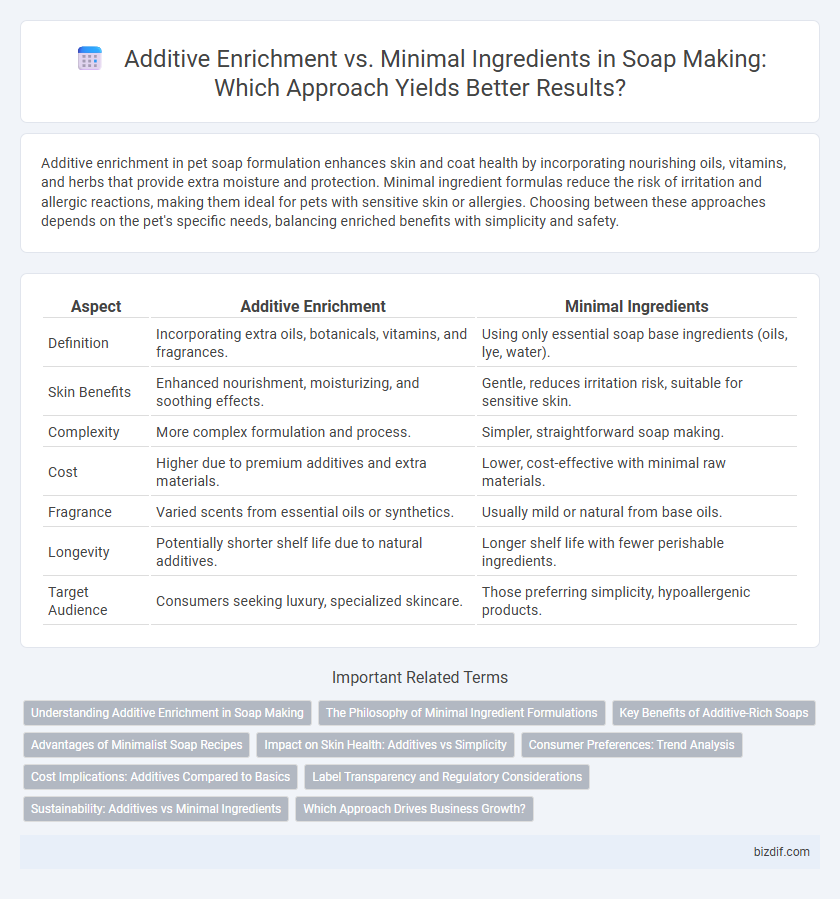Additive enrichment in pet soap formulation enhances skin and coat health by incorporating nourishing oils, vitamins, and herbs that provide extra moisture and protection. Minimal ingredient formulas reduce the risk of irritation and allergic reactions, making them ideal for pets with sensitive skin or allergies. Choosing between these approaches depends on the pet's specific needs, balancing enriched benefits with simplicity and safety.
Table of Comparison
| Aspect | Additive Enrichment | Minimal Ingredients |
|---|---|---|
| Definition | Incorporating extra oils, botanicals, vitamins, and fragrances. | Using only essential soap base ingredients (oils, lye, water). |
| Skin Benefits | Enhanced nourishment, moisturizing, and soothing effects. | Gentle, reduces irritation risk, suitable for sensitive skin. |
| Complexity | More complex formulation and process. | Simpler, straightforward soap making. |
| Cost | Higher due to premium additives and extra materials. | Lower, cost-effective with minimal raw materials. |
| Fragrance | Varied scents from essential oils or synthetics. | Usually mild or natural from base oils. |
| Longevity | Potentially shorter shelf life due to natural additives. | Longer shelf life with fewer perishable ingredients. |
| Target Audience | Consumers seeking luxury, specialized skincare. | Those preferring simplicity, hypoallergenic products. |
Understanding Additive Enrichment in Soap Making
Additive enrichment in soap making involves incorporating natural oils, botanicals, vitamins, or exfoliants to enhance the soap's moisturizing, soothing, and aesthetic qualities. These additives can improve skin benefits and create unique textures or scents, but require precise measurements to maintain soap hardness and lather. Minimal ingredient soap focuses on purity and reduced potential irritants, while additive enrichment targets customization and functional enhancement.
The Philosophy of Minimal Ingredient Formulations
Minimal ingredient formulations in soap making emphasize purity, reducing the potential for skin irritation and allergic reactions by excluding unnecessary additives and preservatives. This philosophy prioritizes natural oils, lye, and water, allowing each component's intrinsic properties to cleanse and nourish the skin effectively. Embracing simplicity enhances transparency and sustainability, aligning with consumer demand for clean, eco-friendly personal care products.
Key Benefits of Additive-Rich Soaps
Additive-rich soaps offer enhanced moisturizing properties and targeted skin benefits by incorporating natural oils, botanical extracts, and vitamins that support skin health and hydration. These enriched soaps provide antioxidants and anti-inflammatory agents, which help soothe irritation and promote a balanced complexion. Formulations with additives can also deliver improved cleansing efficacy while maintaining gentle care for sensitive or dry skin types.
Advantages of Minimalist Soap Recipes
Minimalist soap recipes enhance skin compatibility by reducing the risk of irritation caused by unnecessary additives and chemicals. Using fewer ingredients allows for better control over the soap's quality, ensuring purity and natural benefits from core components like oils and lye. This streamlined approach also simplifies production, making it more accessible for beginners and environmentally friendly by minimizing waste and resource consumption.
Impact on Skin Health: Additives vs Simplicity
Additive enrichment in soap making introduces ingredients like essential oils, vitamins, and botanicals that can target specific skin concerns such as hydration, anti-aging, or soothing irritation, potentially enhancing skin health and sensory experience. In contrast, minimal ingredient formulations reduce the risk of allergic reactions and skin sensitivities by limiting exposure to unnecessary chemicals, making them ideal for sensitive or problem-prone skin. Choosing between additive enrichment and simplicity depends on balancing desired skin benefits with individual skin tolerance and the potential for irritation.
Consumer Preferences: Trend Analysis
Consumers increasingly favor additive enrichment in soap making, valuing ingredients like essential oils, vitamins, and botanicals that enhance skin benefits and sensory experience. However, a growing segment prefers minimal ingredient lists, prioritizing transparency, hypoallergenic properties, and environmental sustainability in their purchasing decisions. Market analysis reveals this dual trend drives innovation, with brands offering both complex formulations and minimalist, clean-label products to meet diverse consumer demands.
Cost Implications: Additives Compared to Basics
Additive enrichment in soap making increases production costs due to the higher price of specialty oils, fragrances, and botanical extracts compared to basic ingredients like lye, water, and standard oils such as olive or coconut. Minimal ingredient formulations reduce expenses by relying on a limited number of cost-effective raw materials, making them ideal for budget-conscious crafters or large-scale production. The decision to incorporate additives directly impacts overall profitability, with enriched soaps often justifying higher retail prices but requiring more investment upfront.
Label Transparency and Regulatory Considerations
Additive enrichment in soap making involves incorporating vitamins, botanicals, and synthetic compounds to enhance product benefits, necessitating detailed label transparency to comply with FDA and EU cosmetic regulations. Minimal ingredients formulations prioritize simplicity and natural content, often easing regulatory scrutiny but requiring clear disclosure to meet allergen and safety standards. Both approaches demand precise ingredient listing to uphold consumer trust and ensure adherence to labeling laws under the Cosmetic Product Safety Report (CPSR) framework.
Sustainability: Additives vs Minimal Ingredients
Additive enrichment in soap making often introduces synthetic fragrances and colorants, increasing environmental impact through chemical runoff and non-biodegradable waste. Minimal ingredient formulations prioritize natural, biodegradable components like olive oil and lye, reducing pollution and resource consumption. Emphasizing sustainability, minimal ingredient soaps support eco-friendly practices by minimizing chemical additives and waste.
Which Approach Drives Business Growth?
Additive enrichment in soap making leverages natural botanicals, vitamins, and essential oils to create premium products that attract discerning customers willing to pay higher prices, driving significant business growth. Conversely, minimal ingredients appeal to eco-conscious consumers seeking simplicity and transparency, fostering brand loyalty and steady sales through trust and sustainability. Brands combining both strategies can optimize market reach by balancing innovation with authenticity, maximizing revenue potential.
Additive Enrichment vs Minimal Ingredients Infographic

 bizdif.com
bizdif.com